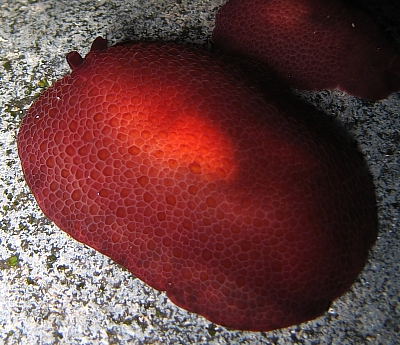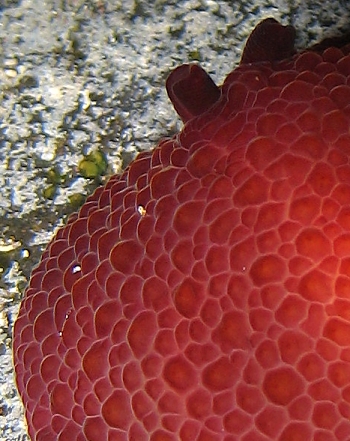Re: Pleurobranchus peroni from N. Sulawesi
December 13, 2006
From: Hugues Flodrops


Concerning message #15349:
Dear Bill,
Here are photos of what Philibert Bidgrain think are Pleurobranchus peroni.
Locality: Côte Rocheuse, Etang-Salé, 0,8 metre, Reunion Island, Indian Ocean, 25 Novembre 2006, Two hours after nightfall. Length: 80 mm and 40 mm. Photographer: Hugues Flodrops.
It's seems the animals are afraid of the light. What are the differences between pleurobranchs and nudibranchs?
Is the orange spot a sign of a small internal shell?
Thanks for your comments.
Regards.
Hugues
hugues.flodrops@wanadoo.fr
Flodrops, H., 2006 (Dec 13) Re: Pleurobranchus peroni from N. Sulawesi. [Message in] Sea Slug Forum. Australian Museum, Sydney. Available from http://www.seaslugforum.net/find/18662
Dear Hugues,
Yes this is a dark form of P. peroni. I have added a close-up alongside showing the nature of the tubercles over the mantle and also the rhinophores or head tentacles. You will notice that these tentacles are formed from the rolling of the tissue into an open tube, much as found in many sacoglossans. Many opisthobranchs are what we call photo-negative, which means they have a tendency to avoid the light. It is why they are often more abundant at night than during the day. This behaviour is normally considered to be a defensive mechanism to avoid being eaten by predatory fish, but in intertidal animals it also a useful measure to stop drying out or getting overheated in the sunlight.
Recent studies are suggesting that the pleurobranchs are quite closely related to the nudibranchs. In the past the Notaspidea [Pleurobranchs + Tylodinoidea] were considered a distinct group of opisthobranchs, just as are the Cephalaspidea [bubble-shells etc], Sacoglossa and the Nudibranchia. It now seems that the Nudibranchs and the Pleurobranchs (but not the Tylodinoidea), have a common evolutionary origin and the term Nudipleura has recently been coined for them.
Two obvious characters which separate the pleurobranchs from the nudibranchs are the enrolled head tentacles and the large gill found along the right side of the body in pleurobranchs. In nudibranchs the head tentacles [ rhinophores] have a very distinctive shape, and the gills, if present, form a circle in the dorsal midline.
Concerning the pale orange patch in the middle of the back. I think this is just a patch of skin in which the pale gonad is showing through. The internal shell in this species is transparent and only thinly calcified. It usually stops growing oonce it reaches about 7 or 8 mm in length, and in animals larger than about 6 cm it is often absent.
Best wishes,
Bill Rudman
Related messages
-
Colour in Pleurobranchus peroni from Reunion Is.
From: Hugues Flodrops, September 22, 2008 -
Pleurobranchus peroni from Reunion Island
From: Hugues Flodrops, September 22, 2008 -
Pleurobranchus peroni from the Seychelles
From: David Barnes, September 18, 2007 -
Re: Pleurobranchus peroni from N. Sulawesi
From: Ron Velarde, December 15, 2006 -
Pleurobranchus peroni from eastern Australia
From: Linda Mougeot, December 7, 2006 -
Pleurobranchus peroni mating?
From: James Spears, May 4, 2006 -
Pleurobranchus peroni from N. Sulawesi
From: Linda Ianniello, December 5, 2005 -
Re: Mystery slug from Malaysia
From: Roberto Sozzani, May 11, 2005 -
Pleurobranchus peroni from Indonesia
From: H.Haluk Akbatur, December 11, 2003 -
Pleurobranchus peroni from Jervis Bay
From: Sue Newson, November 12, 2003 -
Pleurobranchus peroni - Jervis Bay
From: Sue Newson, October 24, 2003 -
Pleurobranchus peroni from Sunshine Coast
From: Gary Cobb, October 21, 2003 -
Juvenile Pleurobranchus peroni
From: Leanne & David Atkinson, May 23, 2003 -
Pleurobranchus peroni from Cook Islands
From: Sonja Miller, December 2, 2002 -
Pleurobranchus peroni from southern Korea
From: Dong Bum, Koh, November 18, 2002 -
Juvenile Pleurobranchus peroni from S. Africa
From: Valda Fraser, October 17, 2002 -
The status of Pleurobranchus hirasei
From: Nishina Masayoshi, July 25, 2002 -
Juvenile Pleurobranchus peroni
From: Nishina Masayoshi, November 2, 2001 -
Pleurobranchus from South Africa
From: Valda Fraser, August 10, 2001 -
Pleurobranchus peroni from New South Wales
From: Patty Jansen, February 24, 2001 -
Pleurobranchus peroni from Sydney
From: Barbara Harvey, March 31, 2000 -
Pleurobranchus peroni from Sth Africa
From: Valda Fraser, December 7, 1999 -
Is this S.African pleurobranch Berthella?
From: Ernest C.J. Seamark, April 18, 1999
